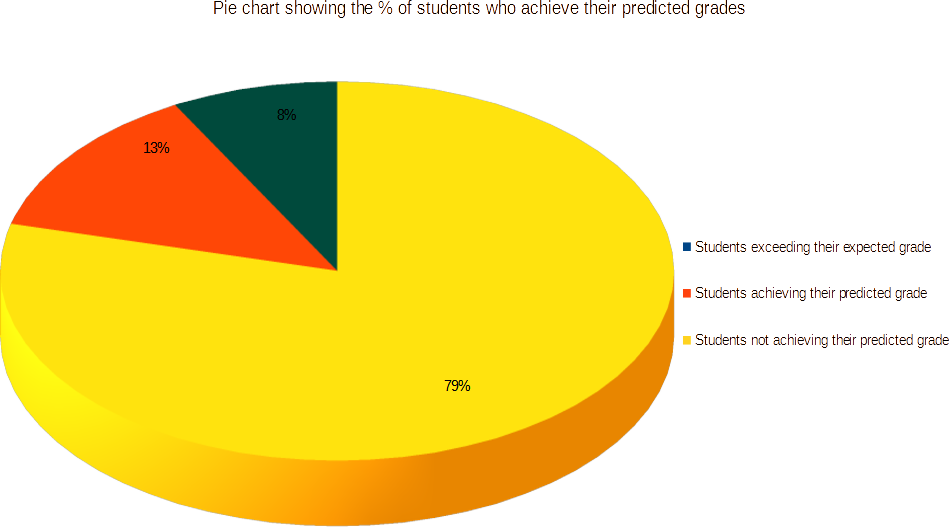So what’s the problem with predicted grades?
Let’s not beat about the bush, predicted grades are a problem. They are primarily used to allow Universities and Sixth Form Colleges to carry out forward planning and make offers to the students that they would like to accept.
The main problem with them: they are normally wrong. In fact, they are very wrong.
In 2019, the last year where we have real data, UCAS recorded that, of 18 year old students who sat 3 A levels
- 13% of these grade predictions were 100% accurate
- 21% of students met or exceeded their predicted grades.
- 79%% of students did not achieve their predicted grades
On average, students are predicted 2.35 A level grades above their achieved grades. An astonishing 9% of students missed their predicted grade by 6 or more A level grades.
These figures are taken from UCAS end of cycle report 2019.
How are predicted grades decided
Tutors use a range of methods to inform predicted grades, including GCSE attainment, internal assessment, school management information services, and their own professional judgment and experience.
Some schools will have more data than others, dependent on factors such as how long a student has attended the institution or how much data they have from a student’s prior school, but ultimately a tutor will make a holistic judgement based on what they know of the student.
It is worth mentioning at this point that Home Schooling Organisations, by their very distance will know a lot less about their students than home tutors, or school based teachers.
So why are teachers so optimistic when predicting grades?
“A self-fulfilling prophecy is the sociopsychological phenomenon of someone “predicting” or expecting something, and this “prediction” or expectation coming true simply because the person believes it will”
Encyclopedia of Philosophy and the Social Sciences,
Let’s talk about motivation. Motivation is one of the most important factors in a student doing well in their studies. Tutors in all organisations will try to foster a student’s enthusiasm and motivation. A tutor will look to reward the student’s achievements throughout their studies and offer encouragement and aspiration. Informing a student that they should aspire to an A is much more likely to encourage a student to get a B than telling a student that they should aim for a C.
This follows on to university offers. If a tutor doesn’t predict high enough grades, then students will only get offers from less prestigious universities. In addition, this will affect motivation, as an offer from the students preferred university might be the difference between them achieving those grades or not.
Consequently, there is a great deal of pressure for tutors to predict high grades and none at all for them to be entirely realistic. Be aware of this, it is important.
Why predictions for 2022 are going to be even harder!
The last time students sat exams is now 2019. In both 2020 and 2021, we saw a step change in the levels of grade inflation. The number of students achieving the top grades has nearly doubled, putting enormous pressure on University Admissions Departments who are legally obliged to provide places for any student who achieves the criteria of an offer they have made. It also makes it much harder for universities to choose the best academic candidates. Realistically, grade inflation can’t continue, but how do you put the genie of grade inflation back in the lamp?
There are a few basic choices
- Grade all students in 2022, when exams are expected to resume, as if they had taken exams in 2019. This will disadvantage 2022 students who will still be competing for jobs and university places with 2021 students, who were twice as likely to achieve a top grade.
- Accept that grade inflation has happened and leave the grading level as it is. This will greatly disadvantage all students who took exams prior to 2020. Students who sat in 2020 and 2021 will also be advantaged against future examined pupils but not by as much.
- Change the grading system from A* to E to a 9 to 1 grading system like the GCSEs. This muddies the water and whilst possible, it causes the greatest disruption to the system and may require more time to implement than is available.
As yet the Department for Education haven’t announced how they are dealing with the step change in grade inflation and until they do, it will be even harder to predict a student outcome or give predicted grades in 2022.
Dealing with predicted grades
The take home lesson from all of this is that as a student you can’t trust that your predicted grade is an accurate assessment of your ability or exam outcome, therefore it is essential to have more than one plan for results day and that that plan should start to be made now;
- Apply to a spread of universities. If you only apply to universities who expect 3A*s you don’t have a safety net in case you don’t reach your goals
- Have a plan for clearing. Universities hate to have empty places on their courses so be aware of how clearing works and how quickly you need to move.
- And finally, please don’t be too harsh if we get your predicted grade wrong because it is likely that we have, we already know this and now hopefully, so do you!
